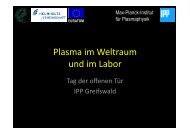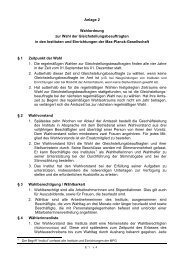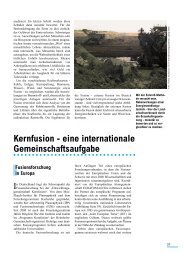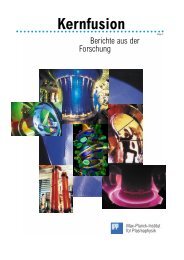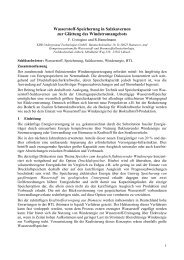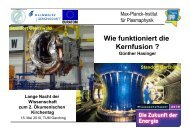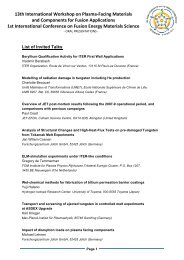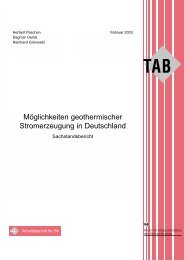IPP Annual Report 2007 - Max-Planck-Institut für Plasmaphysik ...
IPP Annual Report 2007 - Max-Planck-Institut für Plasmaphysik ...
IPP Annual Report 2007 - Max-Planck-Institut für Plasmaphysik ...
Create successful ePaper yourself
Turn your PDF publications into a flip-book with our unique Google optimized e-Paper software.
Plasmagenerator PSI-2<br />
Performing plasma diagnostic<br />
measurements with Langmuir<br />
probes one has to take into consideration<br />
possible disturbances<br />
of the plasma by the probe itself.<br />
Apart from the probe tip, there<br />
is especially the probe shaft that<br />
could influence the results of a<br />
measurement. To resolve this question, measurements were<br />
made of the electron temperature and density using two<br />
Langmuir probes. The probes were arranged in two positions:<br />
In the first case, they were aligned in azimuthal direction<br />
of the PSI-2 plasma column. In the second case, they<br />
were placed in the same axial plane but tilted to each other<br />
in azimuthal direction. Data was acquired keeping one<br />
probe at fixed position while the second one was scanning<br />
the plasma radially. We have found that, irrespective of the<br />
geometry, the electron temperature is not affected by the<br />
probe, however the electron density is. This result can be<br />
explained within a theoretical transport model in which the<br />
probe shaft acts as an additional particle sink (figure 1). It is<br />
interesting to note that the disturbance of the plasma by the<br />
probe takes place on a global scale.<br />
n e and T e [normalized]<br />
1.1<br />
1<br />
0.9<br />
0.8<br />
0.7<br />
T<br />
e<br />
n<br />
e<br />
Model<br />
The flow behaviour of plasmas in contact with a target surface<br />
was investigated. The ion velocity distribution function (ivdf)<br />
of Ar + ions was measured at different displacements from<br />
the target using LIF techniques (see <strong>Annual</strong> <strong>Report</strong> 2006).<br />
In addition to the ivdf, the electron temperature was measured<br />
by means of a Langmuir probe. Assuming T e =T i and combining<br />
the results from the ivdf and Langmuir probe measurements<br />
the Mach number M=u/c s was evaluated (u streaming<br />
velocity, c s =[(T e +T i )/m i ] 1/2 speed of sound). Figure 2 shows M<br />
and the electron density at different axial positions z (spatial resolution<br />
Δz~0.5 mm). Close to the target (z=0) the Mach number<br />
approaches unity in agreement with the prediction by Bohm.<br />
Humboldt-University of Berlin<br />
Arbeitsgruppe <strong>Plasmaphysik</strong><br />
Head: Prof. Dr. Gerd Fußmann<br />
-40 -20 0 20 40<br />
Radial Position x [mm] of Disturbing Probe<br />
Figure 1: Normalized electron density (red) and temperature (blue) measured<br />
at fixed position while a second probe was radially driven. The calculated<br />
density distribution is plotted in black.<br />
The plasma physics group at the Humboldt<br />
University operates the plasma generator PSI-2<br />
and the electron beam ion trap (EBIT). Research<br />
activities comprise basic plasma physics, plasmamaterial<br />
interactions and highly charged ion<br />
processes relevant to fusion experiments. Further<br />
effort is dedicated to the study of plasmoids produced<br />
on water surfaces at atmospheric pressure.<br />
111<br />
Our measurement is thus the<br />
first confirmation of Bohm’s<br />
criterion for conditions relevant<br />
to fusion experiments. An unexpected<br />
result is the short distance<br />
(Δz~5 mm) over which the<br />
final acceleration of the ions to<br />
M=1 takes place. Using a theoretical<br />
presheath model the measured<br />
profiles can be reproduced<br />
by relying on D=20 m 2 s -1 for the perpendicular diffusion coefficient.<br />
However, this D value is unrealistically large to explain<br />
the profiles solely by diffusion. A more refined analysis of our<br />
results suggests that radial electric fields build up in front of the<br />
target causing strong particle transport onto the target surface.<br />
M LIF<br />
M<br />
n LIF<br />
n<br />
-50 -40 -30 -20 -10 0 0<br />
z [mm]<br />
Figure 2: Mach number and electron density as a function of axial position<br />
Electron Beam Ion Trap (EBIT)<br />
To complement earlier work on the line emission from highly<br />
charged tungsten ions (see <strong>Annual</strong> <strong>Report</strong>s 1999 and 2000),<br />
x-ray spectra from Si-like W 60+ to Ne-like W 64+ were measured<br />
in the 1-2 Å wavelength region. Our study includes the directly<br />
excited L-shell spectra as well as the associated satellite<br />
emission originating from dielectronically excited W ions.<br />
Precise knowledge of such data is essential owing to the increasing<br />
use of tungsten as wall material in nuclear fusion<br />
devices. The tungsten ions in the EBIT were produced by<br />
directing a continuous flow of W(CO) 6 gas towards the trap<br />
and ionizing the injected carbonyl compound by the monoenergetic<br />
electron beam. Spectra were obtained for a number<br />
of beam energies between 10 and 20 keV and analyzed<br />
using high resolution x-ray spectroscopy. As an example, in figure<br />
3(a) we present a 15 keV electron beam energy spectrum<br />
showing lines from W 60+ to W 64+ recorded between 1.18 and<br />
1.57 Å. To support our identification of the lines, wavelengths<br />
and intensities were calculated for the ions under investigation<br />
using an atomic structure computer package combined<br />
with a collisional-radiative model (in cooperation with<br />
the division Tokamak Edge and Divertor Physics in Garching).<br />
n 0<br />
M 0<br />
1<br />
0.8<br />
0.6<br />
0.4<br />
0.2<br />
M or n/n 0




